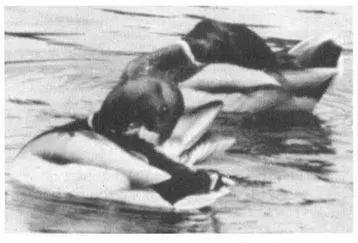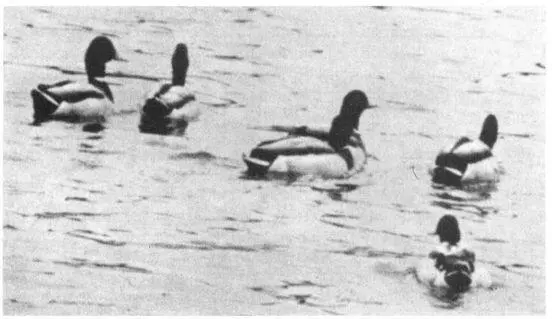Homosexual pair-bonds also occur in both male and female Mallards. As in heterosexual pairs, the two partners keep close company, swimming together as well as resting, preening, and feeding in perfect synchrony. Same-sex partners also “defend” their mate from the approach of other Mallards. Females use a special INCITING display for this, in which they trail their partner while looking back over their shoulder and making a trembling call. Overt sexual activity is not generally a feature of same-sex partnerships, however: drake pairs, for example, engage in mutual head pumping and feather ruffling (which are preludes to copulation) but neither partner mounts the other or invites his mate to mount him. Interestingly, though, some males in homosexual pairs have been observed attempting to rape or forcibly copulate with males outside their pair-bond (just the way drakes in heterosexual pairs often participate in nonmonogamous raping of females—see below). Among females, homosexual pair-bonds are more ephemeral, generally occurring only in the pre-and postbreeding seasons. Some drake pairs are also temporary, while others are long-lasting, persisting for years and possibly even for life.
A homosexual pair of male Mallard Ducks engaging in synchronized preening

A flock, or “club,” of homosexual Mallard drakes

Male Mallards that have been raised together also frequently develop homosexual bonds of great strength and longevity. When large numbers of such birds are present, they often form their own groups, known as CLUBS. They flock together for hours or even days at a time, excitedly running about and swimming together while quacking continuously. Sometimes a female associates herself with a drake pair to form a bisexual trio; although one or both males may mate with her, their homosexual bond remains primary. Less commonly, females that have been raised together may also form a pair-bond, jointly incubating a nest and coparenting any ducklings that may result from promiscuous matings with males.
Blue-winged Teal drakes will court each other in the absence of females, even competing and fighting with one another for the attentions of another male.
Frequency: Homosexual copulations and pairings between female Mallard Ducks occur sporadically and are most common during the fall. In one study, roughly a quarter of the days on which sexual activity was observed included same-sex mountings. The proportion of male homosexual pairs varies between populations, anywhere from 2–19 percent of all pairs.
Orientation: Several forms of bisexuality occur among Mallards: females may participate in homosexual copulations while paired with a male, and both sexes may form seasonal homosexual attachments prior to or following a period of heterosexual mating. Some males are probably more exclusively homosexual, forming ongoing same-sex bonds that last for many years. In addition, most males probably have a bisexual potential: when raised in all-male groups, Mallards usually form lifelong homosexual pairs, and re-pair with other males on being “widowed.” Nevertheless, even among males that have not been raised together, approximately 13–17 percent still participate in homosexual pairing for at least a portion of their lives. In Blue-winged Teals, homosexual behavior appears to be primarily a manifestation of a bisexual potential, since same-sex pairing or courtship have so far only been observed in males isolated from females.
Nonreproductive and Alternative Heterosexualities
Mallard pairs regularly engage in nonreproductive matings. For example, copulation is common during the five-to-seven months that heterosexual couples are together prior to the breeding season (when males are not producing sperm). Later in the breeding season, however, male-female relations are often marked by hostility, since forced copulation or rape is a common feature of opposite-sex interactions in both Mallards and Blue-winged Teals. Following egg-laying, male Mallards regularly abandon their female mates (who thus become “single parents”), congregate in all-male groups, and begin pursuing other females to try to forcibly mate with them. Rapes also occur between paired ducks in both species. As many as a 12–40 males may chase a single female in aerial or aquatic pursuit; drakes have even been known to grab and mount females underwater when they dive (attempting to escape), or to knock females to the ground in midflight. In some populations, as many as 7–10 percent of all females die each year as a result of drownings or other injuries incurred during rapes. Occasionally, males even try to mate with dead females. Even while they are still paired earlier in the breeding season, males frequently court and attempt to mate with (or rape) females other than their mate. About 3–7 percent of offspring are a result of such nonmonogamous matings, and in some populations multiple parentage occurs in at least 17–25 percent of all broods.
Mallards also sometimes form trio-bonds, either one male with two females (2–4 percent of all heterosexual bonds) or, more commonly, two males with one female (3–6 percent of all bonds). Paired males sometimes switch mates during the breeding season as well, and at least 9 percent of all heterosexual couples divorce between breeding seasons. Overall, long-term male-female pair-bonds (lasting two or more seasons) are rare in this species. Mallard mothers can be extremely aggressive in defense of their young, even killing other youngsters that stray from their own broods. In some populations the greatest cause of mortality among ducklings is attacks from other mothers. Occasionally, however, two broods join together and are defended by a single mother for short periods.
Other Species
Homosexual pairs also form among male Wood Ducks ( Aix sponsa) that are raised together; such pairs are lifelong, and the two males may even search for nesting sites together each year. Female Chiloe Wigeons ( Anas sibilatrix ) have also been known to pair together in captivity; the partners remain bonded for many years and each lays eggs in their nest.
Sources
*asterisked references discuss homosexuality/transgender
Bailey, R. O., N. R. Seymour, and G. R. Stewart (1978) “Rape Behavior in Blue-winged Teal.” Auk 95:188-90.
Barash, D. P. (1977) “Sociobiology of Rape in Mallards ( Anas platyrhynchos ): Responses of the Mated Male.” Science 197:788–89.
Boos, J. D., T. D. Nudds, and K. Sjöberg (1989) “Posthatch Brood Amalgamation by Mallards.” Wilson Bulletin 101:503–5.
*Bossema, I., and E. Roemers (1985) “Mating Strategy, Including Mate Choice, in Mallards.” Ardea 73:147–57.
Cheng, K. M., J. T. Burns, and F. McKinney (1983) “Forced Copulation in Captive Mallards. III. Sperm Competition.” Auk 100:302-10.
Evarts, S., and C. J. Williams (1987) “Multiple Paternity in a Wild Population of Mallards.” Auk 104:597–602.
*Geh, G. (1987) “Schein-Kopula bei Weibchen der Stockente Anas platyrhynchos [Pseudo-Copulation of Female Mallard Ducks].” Anzeiger der Ornithologischen Gesellschaft in Bayern 26:131–32.
*Hochbaum, H. A. (1944) The Canvasback on a Prairie Marsh . Washington, D.C.: American Wildlife Institute.
Huxley, J. S. (1912) “A ‘Disharmony’ in the Reproductive Habits of the Wild Duck ( Anas boschas L.).” Biologisches Centralblatt 32:621–23.
Читать дальше

 A flock, or “club,” of homosexual Mallard drakes
A flock, or “club,” of homosexual Mallard drakes 











